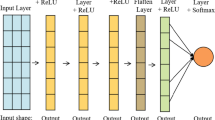Abstract
A recent trend of automatic modulation classification is to automatically learn high-level abstraction of signals, instead of manually designing features for further classification. In this paper, we propose a new deep geometric convolutional network (DGCN) to hierarchically extract discriminative features from Wigner–Ville distribution map of signals. A group of geometric filters are constructed from a least square support vector machine, to capture the linear singularity existed in maps. The filters are cascaded to construct a deep network for extracting discriminative features and classifying signals with different modulation types. Some experiments are taken to investigate the performance of DGCN, and the results show that it can achieve high accuracy in classifying 15 types of modulation signals.








Similar content being viewed by others
References
Dobre, O.A., Abdi, A., Bar-Ness, Y., Su, W.: Survey of automatic modulation classification techniques: classical approaches and new trends. IET Commun. 1(2), 137–156 (2007)
Wei, W., Mendel, J.M.: Maximum-likelihood classification for digital amplitude-phase modulations. IEEE Trans. Commun. 48(2), 189–193 (2000)
Hameed, F., Dobre, O.A., Popescu, D.C.: On the likelihood-based approach to modulation classification. IEEE Trans. Wireless Commun. 8(12), 5884–5892 (2009)
Han, L., Gao, F., Li, Z., Dobre, O.A.: Low complexity automatic modulation classification based on order-statistics. IEEE Trans. Wireless Commun. 16(1), 400–411 (2017)
Aslam, M.W., Zhu, Z., Nandi, A.K.: Automatic modulation classification using combination of genetic programming and KNN. IEEE Trans. Wireless Commun. 11(8), 2742–2750 (2012)
Shi, Y., Zhang, X.D.: A Gabor atom network for signal classification with application in radar target recognition. IEEE Trans. Signal Process. 49(12), 2994–3004 (2001)
Hinton, G.E., Salakhutdinov, R.R.: Reducing the dimensionality of data with neural networks. Science 313(5786), 504–507 (2006)
Bengio, Yoshua, Goodfellow, Ian J., Courville, Aaron: Deep learning. Nature 521, 436–444 (2015)
O’Shea, T., Timothy. J., Corgan, J., Charles Clancy, T.: Convolutional radio modulation recognition networks. In: International Conference on Engineering Applications of Neural Networks. Springer, New York (2016)
O’Shea, T.J., Hitefield, S., Corgan, J.: End-to-end radio traffic sequence recognition with recurrent neural networks. In: 2016 IEEE Global Conference on Signal and Information Processing (GlobalSIP), Washington, DC, pp. 277–281 (2016)
Kim, B., Kim, J., Chae, H., Yoon, D., Choi, J.W.: Deep neural network-based automatic modulation classification technique. In: 2016 International Conference on Information and Communication Technology Convergence (ICTC), Jeju, pp. 579–582 (2016)
Ali, A., Yangyu, F.: Automatic modulation classification using deep learning based on sparse autoencoders with nonnegativity constraints. IEEE Signal Process. Lett. 24(11), 1626–1630 (2017)
Ali, A., Yangyu, F., Liu, S.: Automatic modulation classification of digital modulation signals with stacked autoencoders. Digit. Signal Proc. 71, 108–116 (2017)
Huang, S., Jiang, Y., Gao, Y., Feng, Z., Zhang, P.: Automatic modulation classification using contrastive fully convolutional network. In: IEEE Wireless Communications Letters (in press) (2019)
Lee, J.H., Kim, K.Y., Shin, Y.: Feature image-based automatic modulation classification method using CNN algorithm. InL 2019 International Conference on Artificial Intelligence in Information and Communication (ICAIIC), pp. 1–4 (2019)
Flandrin, P., Rioul, O.: Affine smoothing of the Wigner–Ville distribution. In: International Conference on Acoustics, Speech, and Signal Processing, Albuquerque, NM, Vol. 5, pp. 2455–2458 (1990)
Suykens, J.A., Vandewalle, J.: Least squares support vector machine classifiers. Neural Process. Lett. 9(3), 293–300 (1999)
Yang, S.Y., Wang, M., Zhao, L.F., Wang, Z.Y.: Image noise reduction via geometric multiscale Ridgelet support vector transform and dictionary learning. IEEE Trans. Image Process. 22(11), 4161–4169 (2013)
Lecun, Y., Bottou, L., Bengio, Y., Haffner, P.: Gradient-based learning applied to document recognition. Proc. IEEE 86(11), 2278–2324 (1998)
Kingma, D., Ba, J.: Adam: A method for stochastic optimization. arXiv preprint arXiv:1412.6980 (2014)
Srivastava, N., et al.: Dropout: a simple way to prevent neural networks from overfitting. J. Mach. Learn. Res. 15, 1929–1958 (2014)
Timothy, O., Nathan, W.: Radio machine learning dataset generation with GNU radio. In: Proceedings of the GNU Radio Conference (2016)
Krizhevsky, A., Sutskever, I., Hinton, G.E.: ImageNet classification with deep convolutional neural networks. In: Advances in Neural Information Processing Systems (NIPS) (2012)
Zheng, Z., Zheng, L., Yang, Y.: “A discriminatively learned CNN embedding for person reidentification,” in ACM Trans. Multim. Comput. Commun. Appl. 4(1), 13 (2017)
Acknowledgements
This work was supported by the National Natural Science Foundation of China (Nos. 61771380, 61906145, U1730109, 91438103, 61771376, 61703328, 91438201, U1701267, 61703328); the Equipment pre-research project of the 13th Five-Year Plan (Nos. 6140137050206, 414120101026, 6140312010103, 6141A020223, 6141B06160301, 6141B07090102), the Major Research Plan in Shaanxi Province of China (Nos. 2017ZDXM-GY-103, 017ZDCXL-GY-03-02), the Foundation of the State Key Laboratory of CEMEE (Nos. 2017K0202B, 2018K0101B, 2019K0203B, 2019Z0101B) and the Science Basis Research Program in Shaanxi Province of China (Nos. 16JK1823, 2017JM6086, 2019JQ-663).
Author information
Authors and Affiliations
Corresponding author
Additional information
Publisher's Note
Springer Nature remains neutral with regard to jurisdictional claims in published maps and institutional affiliations.
Rights and permissions
About this article
Cite this article
Li, R., Song, C., Song, Y. et al. Deep geometric convolutional network for automatic modulation classification. SIViP 14, 1199–1205 (2020). https://doi.org/10.1007/s11760-020-01641-3
Received:
Revised:
Accepted:
Published:
Issue Date:
DOI: https://doi.org/10.1007/s11760-020-01641-3




